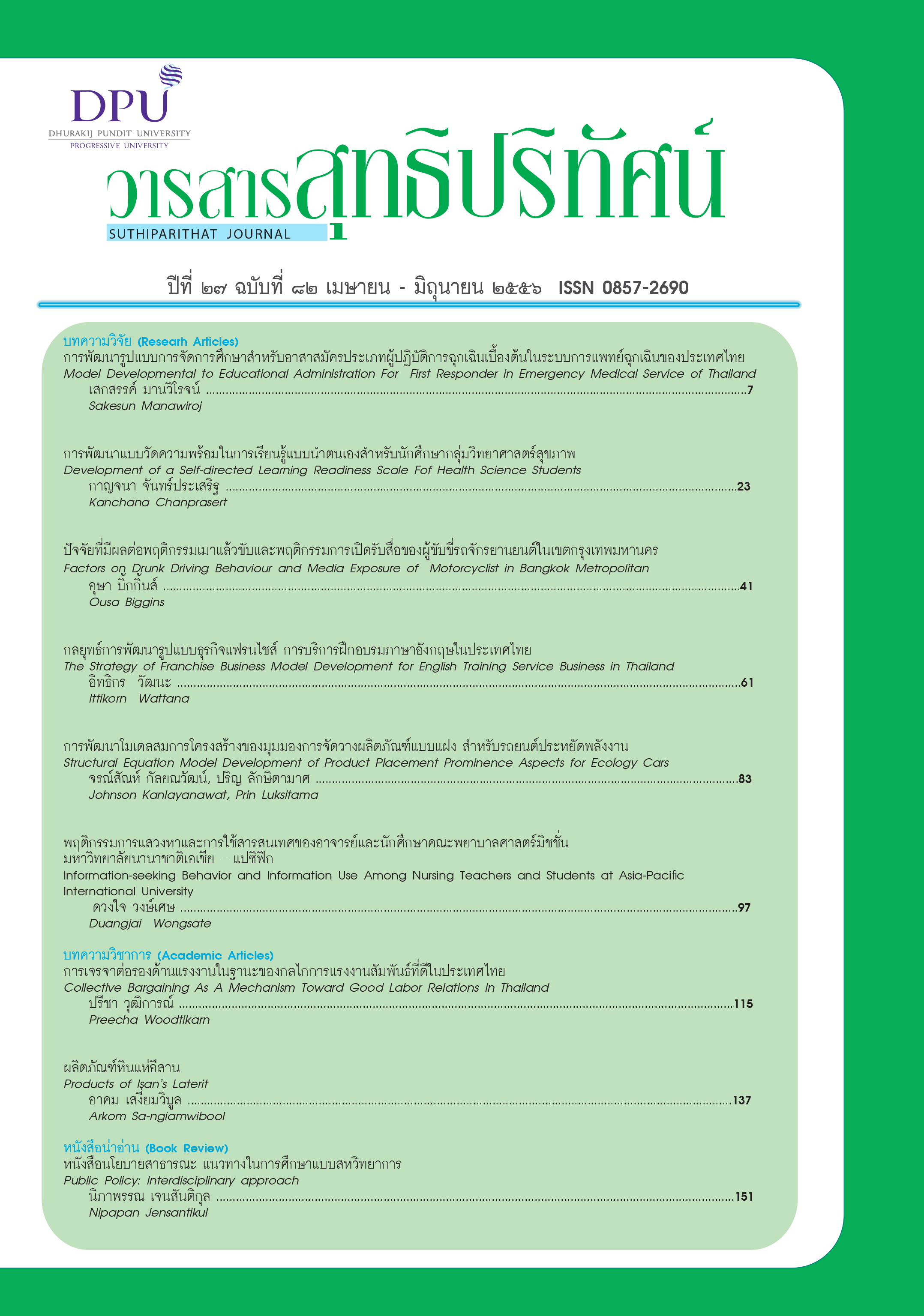STRUCTURAL EQUATION MODEL DEVELOPMENT OF PRODUCT PLACEMENT PROMINENCE ASPECTS FOR ECOLOGY CARS
Keywords:
Product Placement Prominence Aspects, Involvement, Content Integrity, Criticism, Brand EquityAbstract
The study of factors analysis purposes to develop Structure Equation Model (SEM) of the product placement prominence aspects. Using questionnaire as instruments for collecting data from Thai business organization’ officers in the Bangkok Metropolis, and processed by Confirmatory Factor Analysis (CFA) by AMOS program which found that model of the study was valid because the factors loading were more than 0.50 and also had the value of the statistical significant. The factors analysis consists of (1) Involvement had a direct effect to the product placement prominence aspects with the value of the statistical significant of 0.05 (p<0.05). The path coefficient value was 0.832 (DE= 0.832 + IE= 0 = TE = 0.832). (2) Content integrity had a direct the product placement prominence aspects with the value of the statistical significant of 0.05 (p<0.05). The path coefficient value was 0.721 (DE= 0.721+ IE= 0 = TE = 0.721). (3) Criticism had not a direct and an indirect effect to the product placement prominence aspects with the value of the statistical significant of 0.05 (p≥0.05). The path coefficient value was -0.093 (DE= - 0.104 - IE= 0 = TE = -0.104). (4) Brand equity had a direct effect to the product placement prominence aspects with the value of the statistical significant of 0.05 (p<0.05). The path coefficient value was 0.308 (DE= 0.308 + IE= 0 = TE = 0.308).
The process and development for the product placement prominence aspects for ecology cars’ Structural Equation Model (SEM) was 0.832*involvement + 0.721*content integrity - 0.104*criticism + 0.308*brand equity; and the analysis result of model validity (R2) was 88.7 percent.
References
Aaker, D. A. (1991). Managing brand equity New York, NY: The Free Press.
Alwitt, L. & Prabhaker, P. (1994). “Identifying who dislikes television advertising: not by demographics alone” Journal of Advertising Research, 34(6), 17-29.
Anderson, O. E. (2006). “Product placement and other former for non-spot advertising. CBS” Tranberg Marketing Panel for Product Placement.
Bloch, P. H. & Richins, M. L. (1983). “A theoretical model for the study of product important perceptions” Journal of Marketing, 47(2), 69-81.
Celsi, R. L., & Olson, J. C. (1988). “The role of involvement in attention and comprehension processes” Journal of Consumer Research, 15(2), 210-224.
Claire, S. (2010) “Product placement in reality television: An investigation of audience identification and program credibility (Doctoral dissertation, University of Adelaide)” Retrieved December 20, 2011 from http://digital.library.adelaide.edu.au/dspace/bitstream/2440/64113/1/03append-ref.pdf
Gupta, P. B., Balasubramanian, S. K. & Klassen, M. L. (2000). “Viewers’ evaluations of product placements in movies: Public policy issues and managerial implications” Journal of Current Issues and Research in Advertising, 22(2), 41-52.
Houston, M. J. & Rothschild, M. L. (1978). “Conceptual and methodological perspectives on involvement. InJain, S. C. (Ed.)” Research frontiers in marketing: Dialogues and Directions, Chicago, American Marketing Association, 184-187.
Joreskog, K. G. & Sorbom, D. (1993). Lisrel8: Structural Equation Modeling with the Simples command language. Chicago: Software International.
Keller, K. L. (1993). Conceptualizing, measuring, and managing customer-based brand equity. Journal of Marketing, 57(1), 1-22.
Saris, W. E. & Strenkhorst, L. H. (1984). “Causal modeling non experimental research: An Introduction to the Lisrel approach” Dissertation Abstract International, 47(7), 282.
Yamane, T. (1973). Statistics: An introduction analysis (3rd ed.). New York, NY: Harper & Row.
Zaichkowsky, J. L. (1985). “Measuring the Involvement Construct” Journal of Advertising Research, 12(3), 341-352.
Downloads
Published
How to Cite
Issue
Section
License
Content and information of the article published at Suthiparithat Journal are based on the sole opinions and responsibility of author(s) only. Neither the editorial board involve in......







